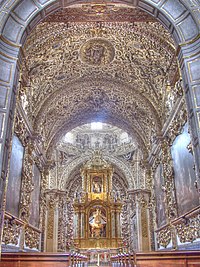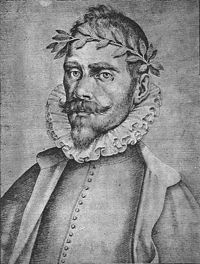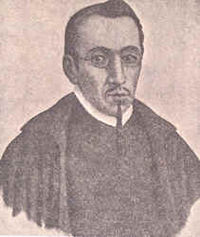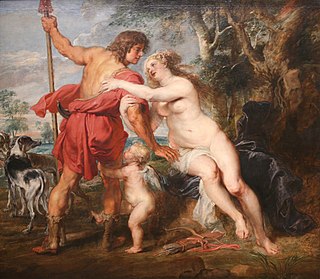
The Baroque is a style of architecture, music, dance, painting, sculpture, poetry, and other arts that flourished in Europe from the early 17th century until the 1750s. In the territories of the Spanish and Portuguese Empires including the Iberian Peninsula it continued, together with new styles, until the first decade of the 19th century. It followed Renaissance art and Mannerism and preceded the Rococo and Neoclassical styles. It was encouraged by the Catholic Church as a means to counter the simplicity and austerity of Protestant architecture, art, and music, though Lutheran Baroque art developed in parts of Europe as well.

Puebla de Zaragoza, formally Heroica Puebla de Zaragoza, formerly Puebla de los Ángeles during colonial times, or known simply as Puebla, is the seat of Puebla Municipality. It is the capital and largest city of the state of Puebla, and the fourth largest city in Mexico, after Mexico City, Monterrey, and Guadalajara. A viceregal era planned city, it is located in the southern part of Central Mexico on the main route between Mexico City and Mexico's main Atlantic port, Veracruz—about 100 km (62 mi) east southeast of Mexico City and about 220 km (140 mi) west of Veracruz.
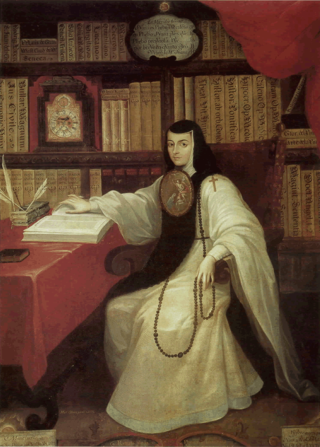
Doña Inés de Asbaje y Ramírez de Santillana, better known as Sor Juana Inés de la Cruz was a Spanish writer, philosopher, composer and poet of the Baroque period, and Hieronymite nun. Her contributions to the Spanish Golden Age gained her the nicknames of "The Tenth Muse" or "The Phoenix of America"; historian Stuart Murray calls her a flame that rose from the ashes of "religious authoritarianism".

Mexican literature is one of the most prolific and influential of Spanish-language literatures along with those of Spain and Argentina. Found among the names of its most important and internationally recognized literary figures are authors Octavio Paz, Alfonso Reyes, Carlos Fuentes, Sergio Pitol, José Emilio Pacheco, Rosario Castellanos, Fernando del Paso, Juan Rulfo, Amado Nervo, Sor Juana Inés de la Cruz, Ramón López Velarde, and Carlos de Sigüenza y Góngora, among others.

The Spanish Golden Age is a period of flourishing in arts and literature in Spain, coinciding with the political rise of the Spanish Empire under the Catholic Monarchs of Spain and the Spanish Habsburgs. The greatest patron of Spanish art and culture during this period was King Philip II (1556–1598), whose royal palace, El Escorial, invited the attention of some of Europe's greatest architects and painters, such as El Greco, who infused Spanish art with foreign styles and helped create a uniquely Spanish style of painting. The period is associated with the reigns of Isabella I, Ferdinand II, Charles V, Philip II, Philip III and Philip IV, when Spain was a rising global superpower.

Churrigueresque, also but less commonly "Ultra Baroque", refers to a Spanish Baroque style of elaborate sculptural architectural ornament which emerged as a manner of stucco decoration in Spain in the late 17th century and was used until about 1750, marked by extreme, expressive and florid decorative detailing, normally found above the entrance on the main facade of a building.

Miguel Mateo Maldonado y Cabrera (1695–1768) was a Mestizo painter born in Oaxaca but moved to Mexico City, the capital of Viceroyalty of New Spain. During his lifetime, he was recognized as the greatest painter in all of New Spain. He created religious and secular art for the Catholic Church and wealthy patrons. His casta paintings, depicting interracial marriage among Amerindians, Spaniards and Africans, are considered among the genre's finest. Cabrera's paintings range from tiny works on copper to enormous canvases and wall paintings. He also designed altarpieces and funerary monuments.
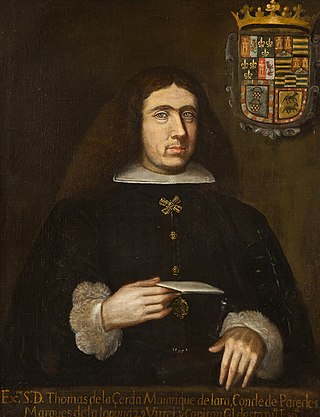
Tomás de la Cerda y Aragón, 3rd Marquess of la Laguna de Camero Viejo, GE, KOA, , was a Spanish nobleman, viceroy of Galicia and of New Spain from 1680 to 1686. He is better known as the Count of Paredes, though he held this title only as consort.

Gaspar de la Cerda Silva Sandoval y Mendoza, 8th Count of Galve, Lord of Salcedón and Tortola was viceroy of New Spain from November 20, 1688, to February 26, 1696.

Don Carlos de Sigüenza y Góngora was one of the first great intellectuals born in the New World - Spanish viceroyalty of New Spain. He was a criollo patriot, exalting New Spain over Old. A polymath and writer, he held many colonial government and academic positions. Sigüenza is considered the da Vinci mexicano.

The Metropolitan Cathedral of the Assumption of the Most Blessed Virgin Mary into Heaven is the cathedral church of the Roman Catholic Archdiocese of Mexico. It is situated on top of the former Aztec sacred precinct near the Templo Mayor on the northern side of the Plaza de la Constitución (Zócalo) in the historic center of Mexico City. The cathedral was built in sections from 1573 to 1813 around the original church that was constructed soon after the Spanish conquest of Tenochtitlan, eventually replacing it entirely. Spanish architect Claudio de Arciniega planned the construction, drawing inspiration from Gothic cathedrals in Spain.

Manuel Vicente Tolsá Sarrión was a prolific Neoclassical architect and sculptor in Spain and Mexico. He served as the first director of the Academy of San Carlos.
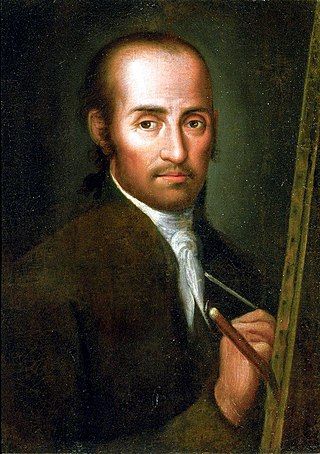
José de Ibarra (1688–1756) was a New Spanish painter. He was born in Guadalajara, Mexico in 1688, and died November 21, 1756, in Mexico City, in the Viceroyalty of New Spain. Ibarra was a disciple of the distinguished painter Juan Correa (1646-1716), whose parents were of Afro-Moorish Afro-Mexican descent. José de Ibarra is, along with Juan Rodríguez Juárez (1675-1728), one of the most prominent figures in painting from the first half of the 18th century in New Spain, modern day's Mexico. A follower of the artistic renewal promoted by the brothers Juan and Nicolás Rodríguez Juárez, in whose workshop he collaborated, Ibarra cultivated in his work the language of pictorial modernism with strong Italian and French influences. This would be the direct antecedent of the work of Miguel Cabrera (1715-1768), whose fame would eclipse that of which Ibarra himself enjoyed among his contemporaries as a brush artist.

Cristóbal de Villalpando was a Baroque Criollo artist from New Spain, arts administrator and captain of the guard. He painted prolifically and produced many Baroque works now displayed in several Mexican cathedrals, including the cathedrals in Querétaro and Mexico City, as well as a depiction of the Zócalo in Mexico City, showing the damage of the 1692 riot to the viceregal palace three years earlier.

Juan Correa (1646–1716) was a Mexican distinguished painter of the late seventeenth and early eighteenth centuries. His years of greatest activity were from 1671 to 1716. He was an Afro-Mexican, the son of a Mulatto or dark-skinned physician from Cádiz, Spain, and a free black woman, Pascuala de Santoyo. Correa "became one of the most prominent artists in New Spain during his lifetime, along with Cristóbal de Villalpando." Manuel Toussaint considers Correa and Villalpando the main exponents of the Baroque style of painting in Mexico. Correa was a very productive religious painter, with two major paintings in sacristy of the Cathedral of Mexico City, one of the Immaculate Conception and the other An Allegory of the Church. He also painted major works for the Jesuit church in Tepozotlan, Mexico. According to Toussaint, Correa is "important in achieving a new quality, in the creative impulse he expresses, and which one cannot doubt embodies the eagerness of New Spain for an art of its own, breaking away from its Spanish lineage. Here New Spain attains its own personality, unique and unmistakable." Correa was José de Ibarra's teacher.

Simon Pereyns was a Flemish painter. He moved to Lisbon, Portugal in 1558 and later to Madrid, Spain. In 1566, he moved to Mexico where he gained fame as a painter of numerous works, most of which have not survived. He created the altarpiece of Huejotzingo at the Franciscan convent of Huejotzingo in Puebla, Mexico, one of the monasteries on the slopes of Popocatépetl. Included in his works is a depiction of Saint Christopher.

The Church of San Felipe Neri, commonly known as "La Profesa", is a Roman Catholic parish church that was established by the Society of Jesus late in the 16th century as the church of a community of professed Jesuits. The church is considered to be an important transitional work between the more sober or moderate Baroque style of the 17th century and the extremely decorated manifestations of the Baroque of the 18th century in Mexico.

Juana Inés, is a Mexican television series co-produced by Canal Once and Bravo Films. The series is created by Patricia Arriaga Jordán, based on the life and work of Sor Juana Inés de la Cruz. The series consists of seven episodes and one season. Series production began on November 4, 2015 in the Ex-Hacienda Santa Mónica, in Mexico City. The series was released on 26 March 2016.

La Dolorosa is a work by Cristóbal de Villalpando probably painted between 1680 and 1689 and belonging to the collection of the Museo Soumaya in Mexico City.
María Luisa Manrique de Lara y Gonzaga, Marchioness of la Laguna, 11th Countess of Paredes was by birth member of the House of Gonzaga and Vicereine of New Spain by virtue of marriage.


